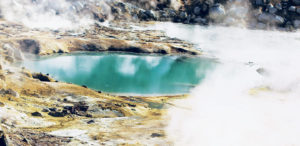by Jack L. Lee, Sep 245, 2020 in Sciencenews
At Bumpass Hell in California’s Lassen Volcanic National Park, the ground is literally boiling, and the aroma of rotten eggs fills the air. Gas bubbles rise through puddles of mud, producing goopy popping sounds. Jets of scorching-hot steam blast from vents in the earth. The fearsome site was named for the cowboy Kendall Bumpass, who in 1865 got too close and stepped through the thin crust. Boiling, acidic water burned his leg so badly that it had to be amputated.
Some scientists contend that life on our planet arose in such seemingly inhospitable conditions. Long before creatures roamed the Earth, hot springs like Bumpass Hell may have promoted chemical reactions that linked together simple molecules in a first step toward complexity. Other scientists, however, place the starting point for Earth’s life underwater, at the deep hydrothermal vents where heated, mineral-rich water billows from cracks in the ocean floor.
As researchers study and debate where and how life on Earth first ignited, their findings offer an important bonus. Understanding the origins of life on this planet could offer hints about where to search for life elsewhere, says Natalie Batalha, an astrophysicist at the University of California, Santa Cruz. “It has very significant implications for the future of space exploration.” Chemist Wenonah Vercoutere agrees. “The rules of physics are the same throughout the whole universe,” says Vercoutere, of NASA’s Ames Research Center in Moffett Field, Calif. “So what is there to say that the rules of biology do not also carry through and are in place and active in the whole universe?”
…

